Disclaimer: This article is for informational purposes only and does not replace professional veterinary advice. Always consult your veterinarian before starting any treatment or supplement for your pet.
Table of Contents
Introduction
Is your dog moving more slowly or skipping their usual jump onto the couch? These subtle changes might be early signs of arthritis in dogs—a condition I see frequently in practice. As a Canadian veterinarian, I often meet pet parents who only realize something’s wrong once their dog is visibly limping. But spotting arthritis in dogs early can make a huge difference in comfort and mobility. With the right care plan, many dogs can stay active and happy for years, even with arthritis. Let’s walk through what to watch for, how to help, and what treatments actually work.
Key Takeaways: Early Arthritis in Dogs
- Arthritis in dogs often starts with subtle signs—like stiffness or reluctance to climb stairs—that are easy to miss.
- Early detection allows for better long-term outcomes, as timely treatment slows joint damage and eases discomfort.
- A combination of vet-prescribed medications, joint supplements, healthy weight management, and gentle exercise can dramatically improve quality of life.
- Small home adjustments like non-slip rugs, orthopedic beds, and raised food bowls make a big difference in comfort.
- Dogs diagnosed early with arthritis tend to maintain mobility longer and enjoy a more active, pain-free life.
Why Early Detection of Dog Arthritis Matters
Arthritis in dogs affects roughly 20% of the canine population, especially as they age. It’s a chronic joint disease that worsens over time if not managed early. What makes it tricky is that dogs are naturally stoic—they hide pain as a survival instinct. This means many cases of arthritis in dogs go unnoticed until the condition is already advanced.
From my own experience as a general practice vet in Ottawa, I’ve seen dogs improve dramatically when treatment starts early. One senior Golden Retriever I treated, Max, was just showing mild stiffness after walks. Because we caught it early, Max started anti-inflammatories and hydrotherapy quickly—and today, he’s still chasing tennis balls at age 11.
Early intervention can significantly reduce pain, preserve joint health, and delay the need for more invasive treatments. When arthritis in dogs is caught at an early stage, it’s much easier to manage symptoms and slow progression—giving your dog more good days with less pain.
Common Early Signs of Arthritis in Dogs
Also visit: https://doglifeexpert.com/2025-indoor-dog-exercise-for-small-spaces/
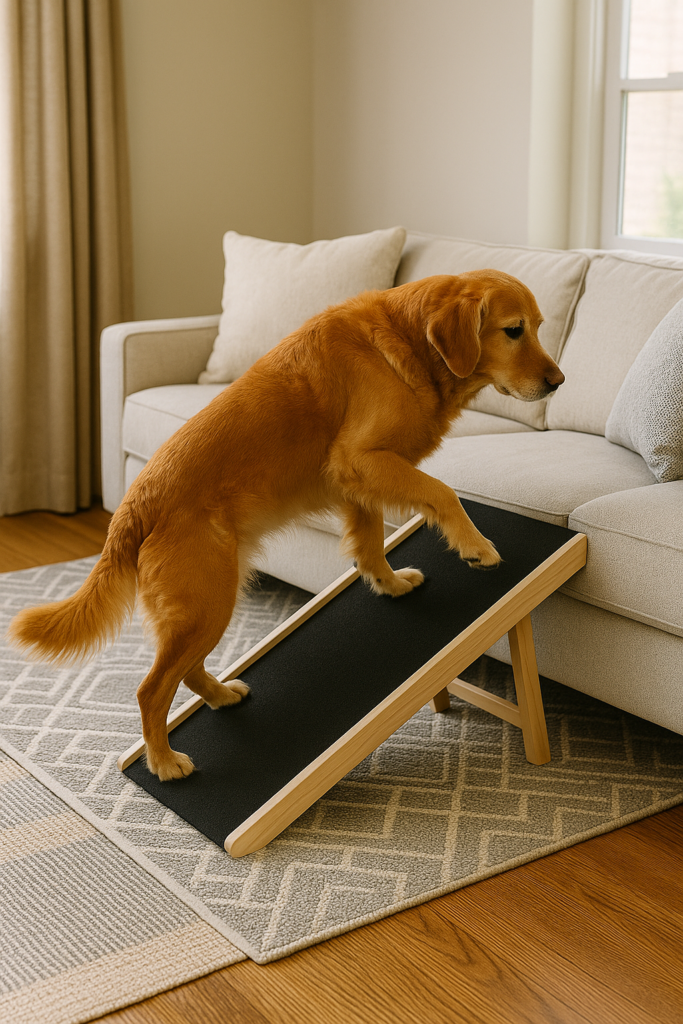
Recognizing the early signs of arthritis in dogs can be life-changing for your pet. Here’s what to watch for:
1. Stiffness or Limping
One of the first signs of arthritis in dogs is stiffness—especially after rest. Your dog may take a few awkward steps when rising or show a slight limp after lying down. It’s often most noticeable in the morning or after a long nap.
2. Hesitation with Stairs or Jumping
Dogs with joint pain may avoid activities they once loved. If your pup hesitates to climb stairs, jump into the car, or get onto the couch, arthritis could be the reason. This reluctance often starts gradually.
3. Reduced Activity or Playfulness
Watch for changes in energy. Dogs with early arthritis often tire quickly on walks or lose interest in playing. They might lag behind or take longer breaks during playtime.
4. Licking or Chewing at Joints
Excessive licking or nibbling at a joint—especially the knees, hips, or wrists—can signal discomfort. It’s your dog’s way of trying to soothe the area.
5. Mood or Behavior Changes
Chronic pain affects personality. Dogs with arthritis may seem withdrawn, irritable, or grumpy—especially when touched near sore spots. If your usually affectionate dog suddenly avoids contact, arthritis could be the cause.
6. Muscle Loss or Weight Gain
Dogs in pain often move less, leading to muscle loss—particularly in the hind legs. You might notice one leg becoming noticeably thinner. Less activity also often leads to weight gain, which worsens arthritis in dogs.
If you spot any of these signs, even subtly, it’s worth bringing up with your vet. Early action leads to better outcomes.
What Increases Arthritis Risk in Dogs?
While arthritis in dogs can affect any breed or age, certain risk factors make some dogs more vulnerable than others.
1. Breed Predisposition
Large and giant breeds—like Labrador Retrievers, Golden Retrievers, German Shepherds, and Rottweilers—are especially prone to arthritis in dogs due to the strain their size puts on joints. Some smaller breeds, like Dachshunds and French Bulldogs, may also develop arthritis, often linked to back or knee issues.
2. Age
Just like people, older dogs are more likely to develop arthritis. Most cases of arthritis in dogs begin around 7 years of age or older, as years of wear and tear break down cartilage and joint fluid.
3. Weight
Extra pounds equal extra pressure on joints. Overweight dogs are significantly more likely to develop arthritis, and their symptoms progress faster. Weight management is one of the most powerful tools for preventing arthritis in dogs.
4. Previous Joint Injury
Dogs who have suffered orthopedic injuries—like a cruciate ligament tear or hip dysplasia—are at increased risk. These conditions often lead to abnormal joint wear and earlier onset of arthritis.
5. Joint Malformations
Conditions like elbow dysplasia or luxating patella can predispose even young dogs to arthritis. These structural issues lead to uneven stress on the joints over time.
Understanding your dog’s risk helps you take preventative steps early, even before signs of arthritis in dogs become obvious.
How Vets Diagnose Arthritis in Dogs
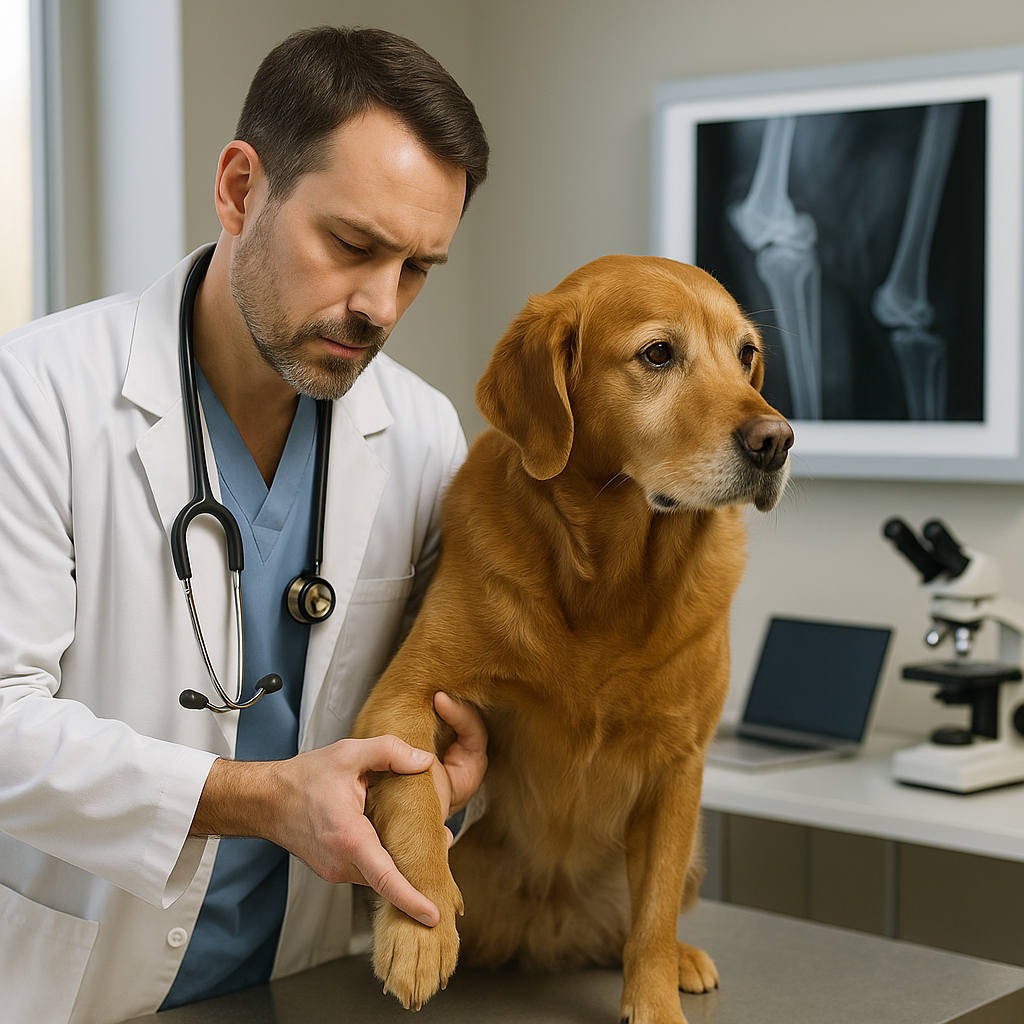
When arthritis in dogs is suspected, your veterinarian will use a combination of observation, examination, and diagnostic tools to confirm the condition and rule out other causes of lameness.
Step 1: Medical History and Physical Exam
Your vet will begin by asking about symptoms—when they started, which joints seem sore, and how your dog is acting at home. During the physical exam, they’ll gently flex and extend the joints to check for pain, reduced range of motion, swelling, or crepitus (a crackling feeling).
Step 2: Gait and Posture Analysis
Many vets observe your dog walking and trotting. Subtle changes in gait or limb placement often reveal early arthritis in dogs, even when obvious limping isn’t present.
Step 3: X-rays
To confirm arthritis in dogs, X-rays are the gold standard. These images can show signs like narrowed joint spaces, bone spurs (osteophytes), and changes to the bone surface. X-rays also help your vet assess how far the arthritis has progressed.
Step 4: Joint Fluid Analysis
In cases where joint swelling is significant or infection is suspected, your vet may perform arthrocentesis—a joint tap that collects fluid for analysis. This test can distinguish between osteoarthritis and other inflammatory conditions like septic arthritis or immune-mediated diseases.
Step 5: Additional Testing
Routine blood work may be done to rule out other causes of stiffness or to ensure your dog is healthy enough to start NSAIDs or other arthritis medications.
Diagnosing arthritis in dogs isn’t always straightforward, especially in the early stages. But the sooner it’s confirmed, the sooner treatment can begin—and that can change your dog’s entire future.
Arthritis Treatments for Dogs
Managing arthritis in dogs involves a multimodal approach—targeting pain relief, joint support, and long-term lifestyle changes. Here’s how veterinarians commonly treat it:
1. Prescription Medications
NSAIDs (non-steroidal anti-inflammatory drugs) like carprofen, meloxicam, or deracoxib are often the first line of treatment. These reduce inflammation and pain but must be prescribed and monitored by a vet. Never give human medications like ibuprofen to dogs.
For more severe pain or nerve-related discomfort, vets may add gabapentin, tramadol, or amantadine.
2. Joint Supplements

Veterinary-formulated supplements containing glucosamine, chondroitin, MSM, and omega-3 fatty acids can help maintain cartilage and joint fluid. Some dogs with arthritis respond noticeably within weeks. Look for products with third-party quality testing, such as Dasuquin Advanced.
3. Therapeutic Diets
Diets like Hill’s j/d, Royal Canin Mobility, or Purina JM are designed for dogs with arthritis. These diets are enriched with anti-inflammatory omega-3s, antioxidants, and cartilage-supportive nutrients.
4. Weight Management
This cannot be overstated: weight loss reduces joint stress and inflammation. A 5–10% drop in body weight can noticeably ease arthritis in dogs. Your vet can help set calorie targets or recommend a prescription weight-loss diet.
5. Physical Rehabilitation
Rehab therapies—like underwater treadmill therapy, laser therapy, massage, and range-of-motion exercises—can significantly improve strength and reduce stiffness. Many vet clinics across Canada now offer these services.
6. Alternative Therapies
Some owners see improvement with acupuncture, chiropractic care, or TCVM (Traditional Chinese Veterinary Medicine). These should be guided by a certified practitioner and used alongside mainstream treatments.
7. Surgery (if needed)
For advanced arthritis in dogs or underlying structural problems (like torn ligaments or hip dysplasia), surgical correction may be necessary. Joint replacement or corrective osteotomy can restore comfort in select cases.
Tailoring treatment to your dog’s stage of arthritis and lifestyle is key. Most dogs need a combination of the above for the best results.
5-Minute Home Checklist for Arthritic Dogs
Making small adjustments around the home can dramatically improve the daily life of a dog with arthritis. Here’s a quick checklist you can go through today:
✅ Ramps & Steps: Install pet ramps or steps to help your dog get onto beds, couches, or into the car—especially if jumping causes strain.
✅ Non-Slip Surfaces: Add area rugs or yoga mats over slippery hardwood or tile to prevent falls and joint jolts.
✅ Orthopedic Bed: Use a memory foam or orthopedic dog bed to cushion sore joints. Position it in a warm, draft-free area.
✅ Raised Bowls: Elevate food and water bowls to shoulder height to reduce strain on the neck and shoulders.
✅ Nail Care: Keep nails trimmed short to improve traction. Long nails can alter paw alignment and worsen joint stress.
✅ Joint-Friendly Toys: Offer soft chew toys or puzzle feeders instead of high-impact fetch games.
A few of these changes can reduce the daily stress on joints and make life easier for a dog with arthritis.
Cost of Managing Dog Arthritis in Canada
The cost of treating arthritis in dogs varies based on severity, region, and chosen therapies. Here’s a general breakdown of typical Canadian veterinary costs (in CAD):
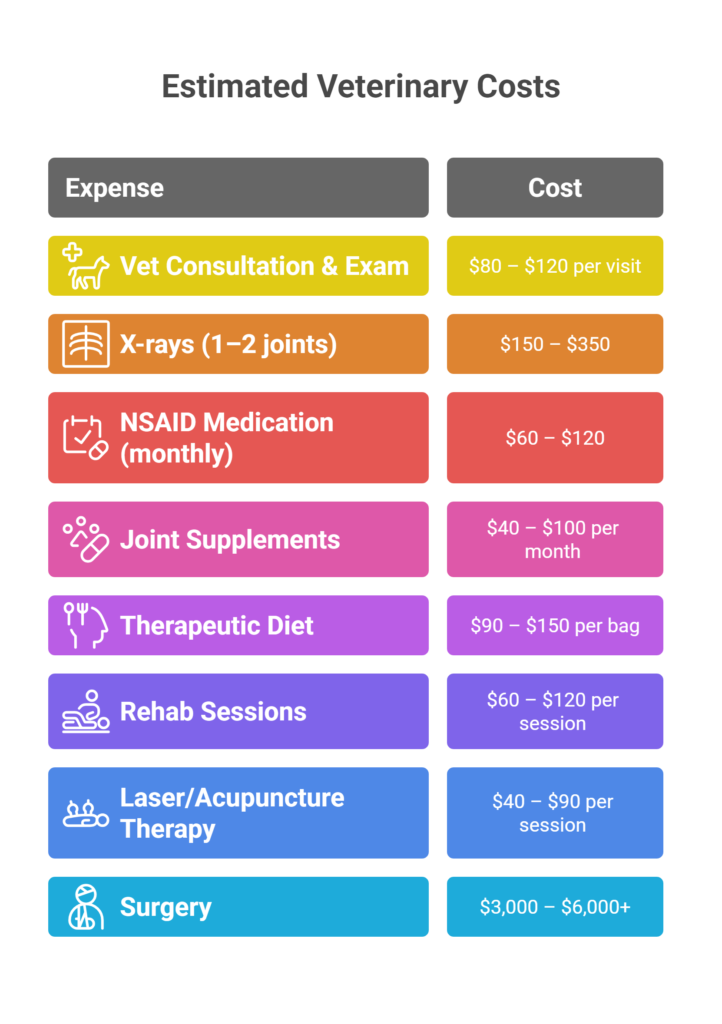
Tip: Many clinics now offer arthritis packages or senior wellness plans that bundle care at reduced costs. Ask your vet about financing options or whether pet insurance covers arthritis in dogs (some do, especially if enrolled before diagnosis).
https://www.acvs.org/small-animal/osteoarthritis
Lifestyle Tips to Help Dogs with Arthritis
Caring for a dog with arthritis doesn’t stop at the vet’s office. Your daily routines can play a big role in managing arthritis in dogs and helping them stay comfortable.
🔹 Maintain a Healthy Weight
Excess weight puts more strain on joints. Stick to measured meals, avoid table scraps, and ask your vet for a calorie plan if needed. Even modest weight loss can dramatically reduce arthritis symptoms.
🔹 Use an Anti-Inflammatory Diet
Diets rich in omega-3 fatty acids (like those found in fish oil) can help reduce joint inflammation. Talk to your vet about adding a canine-safe omega-3 supplement or switching to a joint-support diet like Royal Canin Mobility.
🔹 Keep Exercise Gentle and Consistent
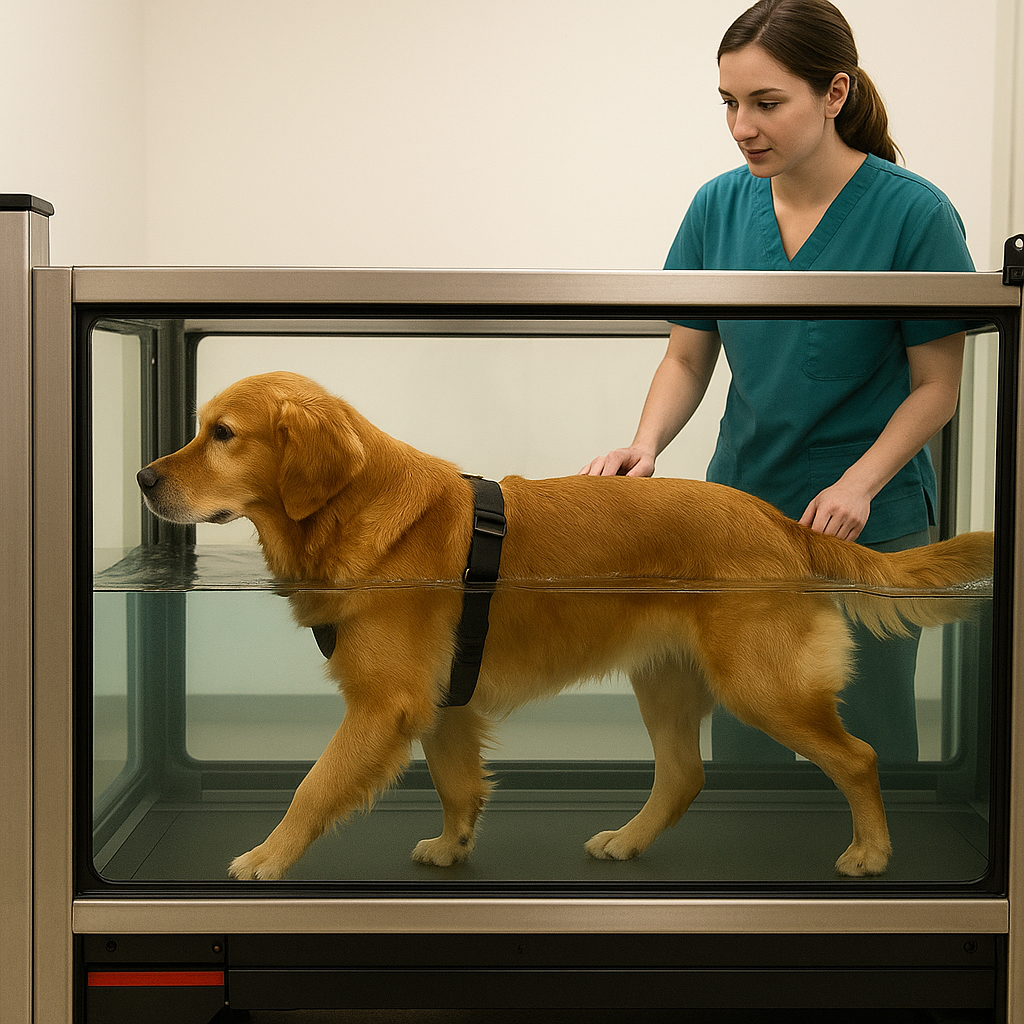
Daily walks are important—even short ones. Stick to flat, soft surfaces (like grass) and avoid activities that involve jumping or sharp turns. Swimming is ideal if available, as it builds muscle without stressing joints.
🔹 Make Grooming Easy
Keep grooming sessions low-stress. Brush your dog regularly, trim nails to avoid traction issues, and consider light massage to relax stiff muscles. Gentle joint range-of-motion exercises (as guided by your vet) can also help.
🔹 Monitor and Adjust
Dogs’ arthritis needs can change. Keep a journal of any stiffness, limping, or mood changes and bring it to vet visits. Adjust medications, supplements, or exercise based on how your dog is doing.
By being consistent and attentive, you can greatly improve daily comfort for dogs living with arthritis.
FAQ: Common Questions About Arthritis in Dogs
❓ Can arthritis in dogs be reversed?
No, arthritis in dogs is a degenerative condition, meaning it can’t be reversed. However, early and consistent treatment can significantly slow its progression and improve quality of life.
❓ What’s the best supplement for dogs with arthritis?
There’s no one-size-fits-all, but supplements with glucosamine, chondroitin, MSM, and omega-3s are commonly recommended. Brands like Dasuquin and Movoflex are widely trusted. Always consult your vet before starting any supplement.
❓ Can puppies get arthritis?
Yes—though rare, puppies can develop arthritis due to joint abnormalities like elbow dysplasia or trauma. Early-onset arthritis in dogs should always be evaluated by a vet.
❓ Is arthritis fatal for dogs?
Arthritis itself isn’t fatal, but unmanaged pain can lead to a reduced quality of life. Severe arthritis in dogs may eventually affect mobility to the point that quality-of-life discussions become necessary.
❓ How long can a dog live with arthritis?
With proper care, many dogs live for years after an arthritis diagnosis. Early intervention, pain control, and lifestyle adjustments help maintain mobility and comfort well into senior years.
❓ Should I walk a dog with arthritis?
Yes! Gentle, regular walks are beneficial. Avoid overexertion or rough terrain, but keeping your dog moving helps strengthen muscles and support joint function.
Final Thoughts: Stay Ahead of Arthritis
Arthritis in dogs doesn’t have to mean a life of pain and inactivity. When caught early and managed proactively, many dogs continue to enjoy long, happy lives filled with walks, play, and tail wags. As a vet, I’ve seen firsthand how small changes—from early NSAID use to adding a ramp at home—can have a huge impact.
The key is to stay vigilant. Don’t brush off stiffness or mood changes as “just aging.” Bring up even subtle concerns with your vet. Together, you can build a plan to keep your dog moving comfortably.
By combining early recognition, personalized vet care, joint-friendly nutrition, and daily support, you’ll be giving your dog the best chance to stay active—despite arthritis.

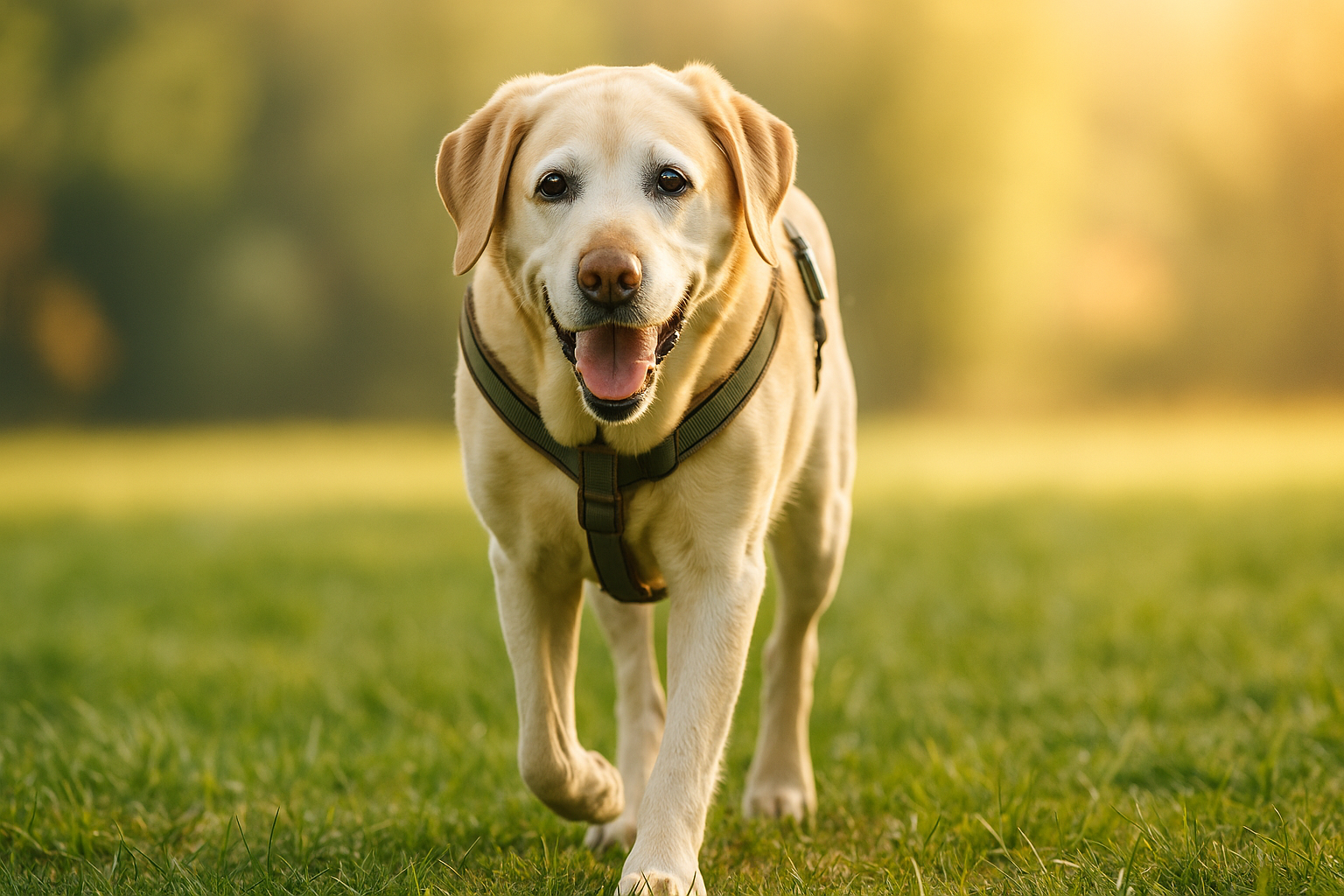

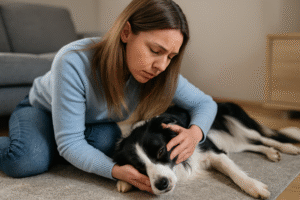

Pingback: 2025 Top Benefits of Agility Training for Dogs: Vet Advice
Pingback: Empowered Canine Acupuncture Guide 2025: Key Points, Meridians & Health Benefits
Pingback: CBD for Dogs: 7 Proven Benefits for Anxiety, Pain
Pingback: Glucosamine Chondroitin for Dogs: Do These Joint Supplements